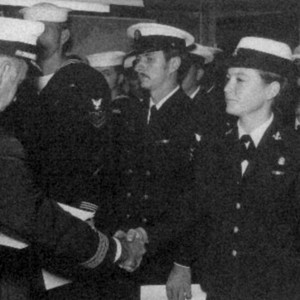Women Divers: Part of the Navy Team
Gender rules, tradition, and equipment discouraged women from becoming divers. Navy divers were exclusively male for over one hundred years, in part because Navy regulations barred women from training as divers until the 1970s. Dive gear, designed to fit men, was heavy and oversized for female divers.
Personnelman Seaman Kati Garner broke the first gender barrier, qualifying as the Navy’s first female SCUBA diver in November 1973. She later reflected, “I knew I was going to finish it because I couldn’t see myself dropping out.” A year and a half later, Hull Technician Fireman Donna Tobias made history by graduating from the Navy’s Deep Sea Diving School in March 1975 as the Navy’s first female deep-sea diver. “She had to prove herself, to be twice as good at everything, and she was,” remembered retired Master Diver Steven Lechner.
This exhibit examines the challenges and achievements of some of the first women divers in the Navy. Through determination, persistence, and a love of diving, these early pioneers proved themselves in a male-dominated world to become valued, respected members of the Navy diving community.
Use the tabs below to explore their experiences in their own words.
“Babe, what do you want to be a diver for?”
Women became Navy divers for many reasons. Some had loved the water as children. TV shows such as Sea Hunt captured the interest of others. Some women, after they joined the Navy, became fascinated with the work the divers did. And some wanted a career where the standards for women were the same as those for men.
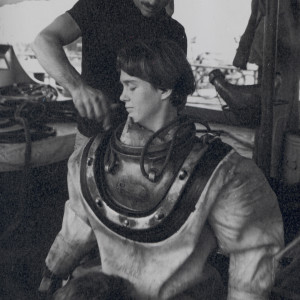 Mary Bonnin became interested in diving when working at the Norfolk Naval Shipyard. A dive school slot became available to her unit when a male sailor decided not to go. A Chief Warrant Officer told Mary, “You couldn’t do it. Babe, what do you want to be a diver for? You’ll be thrown out of that school in a week.” His challenge made her determined to succeed.
Mary Bonnin became interested in diving when working at the Norfolk Naval Shipyard. A dive school slot became available to her unit when a male sailor decided not to go. A Chief Warrant Officer told Mary, “You couldn’t do it. Babe, what do you want to be a diver for? You’ll be thrown out of that school in a week.” His challenge made her determined to succeed.
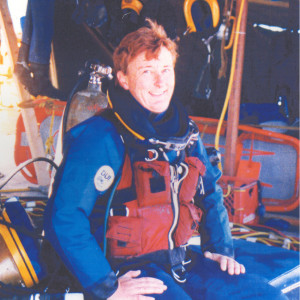 “When I first came into the program there weren’t many sea billets available to women and this was one way to get to go to sea.”
“When I first came into the program there weren’t many sea billets available to women and this was one way to get to go to sea.”
Debra Bodenstedt
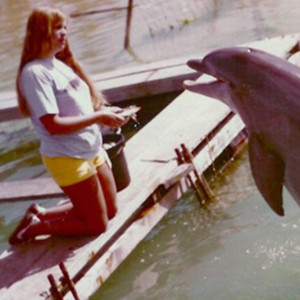 “It was like being a visitor in another world. I loved working in the water. I love the oceans, the marine life, the entire experience…still to this day.”
“It was like being a visitor in another world. I loved working in the water. I love the oceans, the marine life, the entire experience…still to this day.”
Linda Hubbell
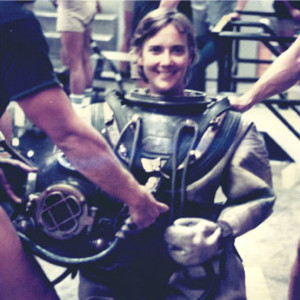 “Every summer, come Memorial Day, no matter how cold and bleak it was in western Pennsylvania, my mother would take us children to the …swimming pool…Then came the TV show Sea Hunt…and the seeds were sown.”
“Every summer, come Memorial Day, no matter how cold and bleak it was in western Pennsylvania, my mother would take us children to the …swimming pool…Then came the TV show Sea Hunt…and the seeds were sown.”
Marie Knafelc
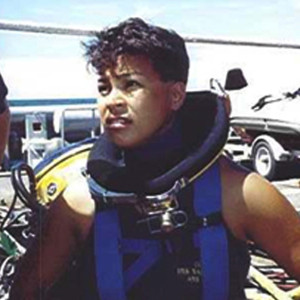 “When I was 8 years old, I was a near-drowning victim and had to be resuscitated. From then on, I told myself I would conquer both the seas and my fear of the seas by learning more and becoming part of the underwater environment. I took swimming lessons and gradually eased my way back into the water…and eventually earned a degree in oceanography.”
“When I was 8 years old, I was a near-drowning victim and had to be resuscitated. From then on, I told myself I would conquer both the seas and my fear of the seas by learning more and becoming part of the underwater environment. I took swimming lessons and gradually eased my way back into the water…and eventually earned a degree in oceanography.”
Bette Bolivar Bush
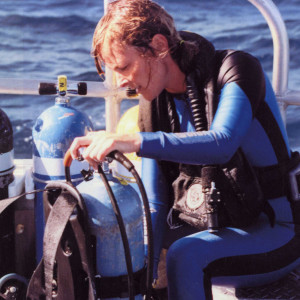 “A friend wanted to take lessons and needed a buddy, so I went through the dive lessons with him and got qualified and then found out I really enjoyed it.”
“A friend wanted to take lessons and needed a buddy, so I went through the dive lessons with him and got qualified and then found out I really enjoyed it.”
Karin Lynn
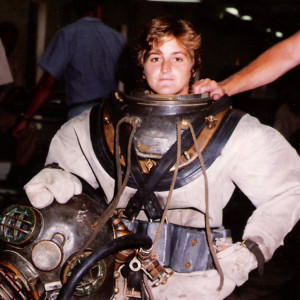 “What really got me into diving was that the standards for women were the same [as for men]. Women had to do the same number of sit-ups and push-ups. They had to climb up and down the dive ladders wearing the same 200-pound Mark V dive system.”
“What really got me into diving was that the standards for women were the same [as for men]. Women had to do the same number of sit-ups and push-ups. They had to climb up and down the dive ladders wearing the same 200-pound Mark V dive system.”
Karen Kohanowich
Anatomy is Not Destiny
Diving officials often cited the physical differences between men and women to discourage women from becoming divers. Less upper body strength, less aerobic capacity, higher risk of the bends, hormonal differences, and pregnancy were used as reasons for them not to dive.
Medical science has disproved these ideas about women’s physiological fitness for diving. Today the primary restriction to diving is pregnancy. The physical qualification for women divers is the same as those for men: be physically fit and in good health.
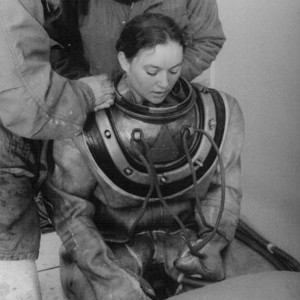 Donna Tobias became the first woman to graduate from the Navy’s Deep Sea Diving School in 1975. She had to handle some 200 pounds of gear, including a Mark V dive helmet, weighted boots, and a heavy canvas suit. She dove in water that was often dark, cold, and turbulent, accompanied by men, some of whom were supportive and many more who resented her invasion of their domain.
Donna Tobias became the first woman to graduate from the Navy’s Deep Sea Diving School in 1975. She had to handle some 200 pounds of gear, including a Mark V dive helmet, weighted boots, and a heavy canvas suit. She dove in water that was often dark, cold, and turbulent, accompanied by men, some of whom were supportive and many more who resented her invasion of their domain.
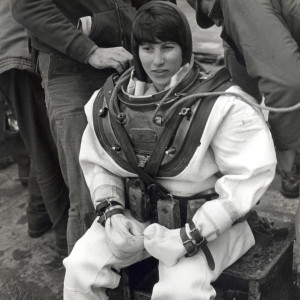 “…since I was small, nothing fit well. The dive dresses were too big, the boots were too big, and the breastplate stuck over my shoulders by several inches. I sewed towels into my shirts, making me look like a football player. This allowed the breastplate to sit higher, giving me some room to move my arms up. I wore my shoes covered by a pair of socks inside the boots so that the boots would not fall off of my feet. My tenders had to put three leather belts on my arms so that when the suit pressurized, the gloves would not blow off of my hands (it didn’t work).”
“…since I was small, nothing fit well. The dive dresses were too big, the boots were too big, and the breastplate stuck over my shoulders by several inches. I sewed towels into my shirts, making me look like a football player. This allowed the breastplate to sit higher, giving me some room to move my arms up. I wore my shoes covered by a pair of socks inside the boots so that the boots would not fall off of my feet. My tenders had to put three leather belts on my arms so that when the suit pressurized, the gloves would not blow off of my hands (it didn’t work).”
Sue Trukken
 “Showing up at the Navy dive school as a 5 foot 4 inch, 120-pound woman, I was met with some skepticism. Though a few men had a problem of a woman in a ‘man’s profession’, the critical fact was I was small and the Mark V diving rig I had to dive and climb out of the water in weighed close to 250 pounds in the dry.”
“Showing up at the Navy dive school as a 5 foot 4 inch, 120-pound woman, I was met with some skepticism. Though a few men had a problem of a woman in a ‘man’s profession’, the critical fact was I was small and the Mark V diving rig I had to dive and climb out of the water in weighed close to 250 pounds in the dry.”
Marie Knafelc
Challenge and Determination
In the face of physical hardship and institutional barriers, the first women Navy divers were determined. They struggled with equipment sized for larger bodies and an organization that was not always welcoming.
If you ever uttered the words, ‘I quit,’ you could never take them back, and there were plenty of eyes waiting to see me fail. I didn’t want them asking less of women, for anything.”
Donna Tobias
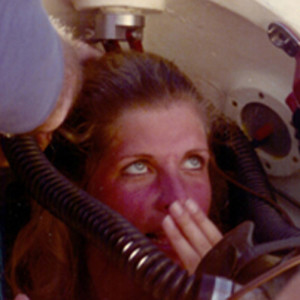 “Being a female Navy diver has to do with perseverance. You get tired of being told you can’t go on some job because you might get hurt.”
“Being a female Navy diver has to do with perseverance. You get tired of being told you can’t go on some job because you might get hurt.”
Linda Hubbell
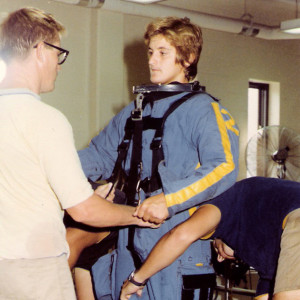 “You need to be strong. You need to be dedicated. You need to practice. You need to be serious about it.”
“You need to be strong. You need to be dedicated. You need to practice. You need to be serious about it.”
Karen Kohanowich
 “It’s a matter of determination rather than skills. It helps to have someone behind you telling you that you can’t do it. To work in a man’s world you have to have an awful, awful lot of patience.”
“It’s a matter of determination rather than skills. It helps to have someone behind you telling you that you can’t do it. To work in a man’s world you have to have an awful, awful lot of patience.”
Mary Bonnin
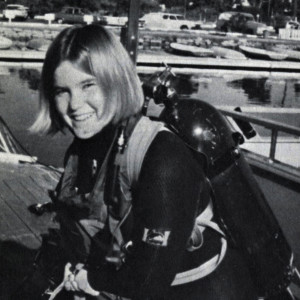 “I was getting so tired, I think I was in bed about 7 o’clock every night. But I knew I was going to finish [Navy scuba school] because I couldn’t see myself dropping out.”
“I was getting so tired, I think I was in bed about 7 o’clock every night. But I knew I was going to finish [Navy scuba school] because I couldn’t see myself dropping out.”
Kati Garner
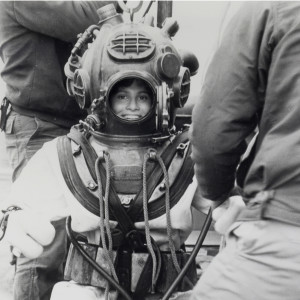 “My diving class started out with 20 diving candidates of whom I was the only woman. By the end of the first two weeks we were down to thirteen. I survived this attrition by smiling the whole way through physical training and working myself to death.”
“My diving class started out with 20 diving candidates of whom I was the only woman. By the end of the first two weeks we were down to thirteen. I survived this attrition by smiling the whole way through physical training and working myself to death.”
Sue Trukken
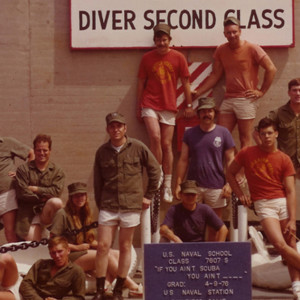 “[My detailer] on the phone was offering me a job in Hawaii as an assistant biology technical officer. Only catch, I had to go to Navy [SCUBA] diving school. Then he informed me there was one other bit of news that went with this diving school stuff. I would be the first female officer to ever go through [SCUBA school]. My Dad was a Navy Seabee qualified in underwater demolition, and I knew what Navy diving school meant. Gulp.”
“[My detailer] on the phone was offering me a job in Hawaii as an assistant biology technical officer. Only catch, I had to go to Navy [SCUBA] diving school. Then he informed me there was one other bit of news that went with this diving school stuff. I would be the first female officer to ever go through [SCUBA school]. My Dad was a Navy Seabee qualified in underwater demolition, and I knew what Navy diving school meant. Gulp.”
Linda Hubbell
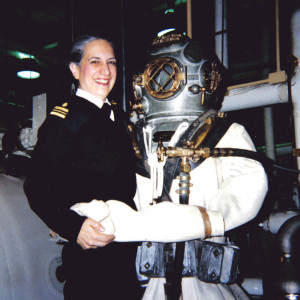 “…it’s very hard work… but it’s something that if you really want…in your life you just go for that. And so once you work that hard and you do it…you become…part of an elite group of people…”
“…it’s very hard work… but it’s something that if you really want…in your life you just go for that. And so once you work that hard and you do it…you become…part of an elite group of people…”
René Hernandez
 “Diving and submarine duty were part of the job that I had to do. To make a naval career in diving medicine, I had to become qualified in submarines. A dive school classmate found a submarine commanding officer willing to have a woman undersea medical officer to care for his crew. Because I was willing to go down in the bilges, through sonar domes, crawl up inside a missile and learn whatever the crew was willing to teach… [I] broke down any barriers the crew may have had when I initially appeared on deck.”
“Diving and submarine duty were part of the job that I had to do. To make a naval career in diving medicine, I had to become qualified in submarines. A dive school classmate found a submarine commanding officer willing to have a woman undersea medical officer to care for his crew. Because I was willing to go down in the bilges, through sonar domes, crawl up inside a missile and learn whatever the crew was willing to teach… [I] broke down any barriers the crew may have had when I initially appeared on deck.”
Marie Knafelc
Teamwork
A diver’s life depends on being part of a team. Divers train and dive in teams. Divers working in the water are supported by their shipmates on the surface. Teamwork is at the core of everything divers do.
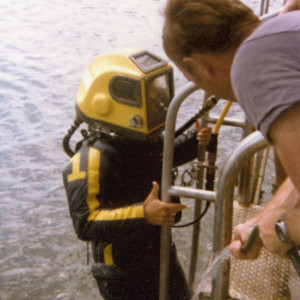 “…the diving community is also a very tight-knit, close group….the friends that I made at the Supervisor of Salvage and Diving…have been friends for life.”
“…the diving community is also a very tight-knit, close group….the friends that I made at the Supervisor of Salvage and Diving…have been friends for life.”
Karin Lynn
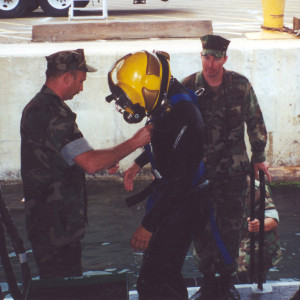 “…women are part of the community within the Navy divers, and they are equally trained, equally capable, and equally successful as their male counterparts…you get out of it what you put into it.”
“…women are part of the community within the Navy divers, and they are equally trained, equally capable, and equally successful as their male counterparts…you get out of it what you put into it.”
Debra Bodenstedt
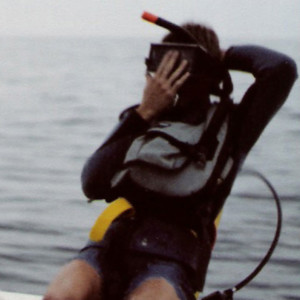 “…having separate standards is almost like sabotage. There’s no way you can have a good team. You know, what we’re here for is to do the work and be part of the team.”
“…having separate standards is almost like sabotage. There’s no way you can have a good team. You know, what we’re here for is to do the work and be part of the team.”
Karen Kohanowich
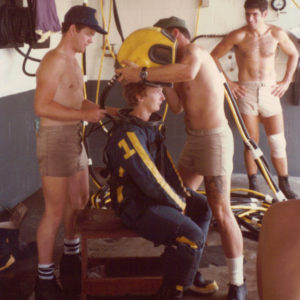 “One of the other jobs that I’m probably most proud of was, while [I was] CO of this underwater ships husbandry unit, we removed 30-ton propellers from a carrier in the water…That is quite a task, an engineering feat, that’s done underwater.”
“One of the other jobs that I’m probably most proud of was, while [I was] CO of this underwater ships husbandry unit, we removed 30-ton propellers from a carrier in the water…That is quite a task, an engineering feat, that’s done underwater.”
Debra Bodenstedt
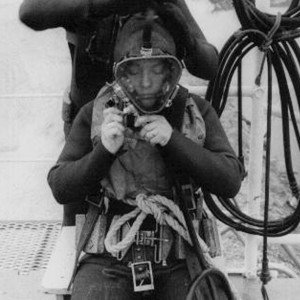 “And one of the things that exists…is the camaraderie. We all have each other’s lives in our hands. …But you’re all in it together…you get weary together, and you get cold together, and you laugh together.”
“And one of the things that exists…is the camaraderie. We all have each other’s lives in our hands. …But you’re all in it together…you get weary together, and you get cold together, and you laugh together.”
Donna Tobias
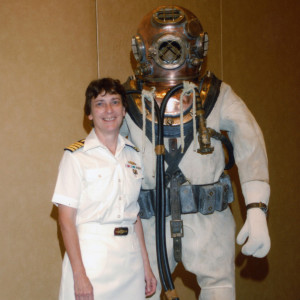 “When divers see a dive-pin on your chest, no matter who you are, they know you went through a rite of passage unique among divers. Everyone went through the same rigors of physical training. Navy diving is based up on a buddy system. Your life depends upon that buddy in the water with you. You have to trust them in their knowledge and ability, as well as they have to trust you to take care of them if things go sideways. The result is that the Navy diving community is another family within the Navy family.”
“When divers see a dive-pin on your chest, no matter who you are, they know you went through a rite of passage unique among divers. Everyone went through the same rigors of physical training. Navy diving is based up on a buddy system. Your life depends upon that buddy in the water with you. You have to trust them in their knowledge and ability, as well as they have to trust you to take care of them if things go sideways. The result is that the Navy diving community is another family within the Navy family.”
Marie Knafelc
Biographies
Learn more about the women divers originally featured in this exhibit and about other female Navy divers who also helped pave the way.
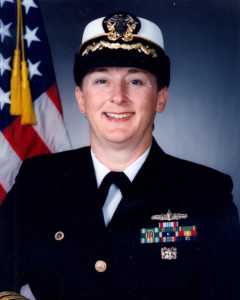 Debra Bodenstedt, Captain, U.S. Navy (Retired)
Debra Bodenstedt, Captain, U.S. Navy (Retired)
Captain Debra Bodenstedt qualified as a SCUBA, surface-supplied, and mixed gas diver in 1983. In 1984, she became the first woman to qualify as a submarine rescue chamber operator, and was the first woman to command the Consolidated Divers Unit in San Diego from 1998–2000. Captain Bodenstedt worked on the Challenger recovery in 1986 and dove on the USS Monitor salvage expedition in 2001. She was inducted into the Women Divers Hall of Fame in 2002.
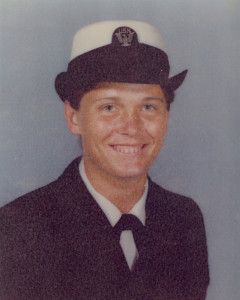 Mary Bonnin, Master Chief Electrician’s Mate, U.S. Navy (Retired)
Mary Bonnin, Master Chief Electrician’s Mate, U.S. Navy (Retired)
Master Chief Mary Bonnin earned her initial diving qualification in 1977. When she graduated from First Class Diving School in 1981 at the top of her class, she received the Honor Person designation and became the first woman to qualify as a Diver First Class. During the seven years she spent as a Navy diving instructor, Master Chief Bonnin trained more than 1,000 divers. In 1990, she earned the title of Master Diver and remains the only woman to do so. She was inducted into the Women Divers Hall of Fame in 2001.
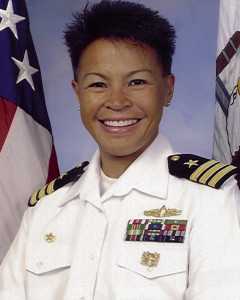 Bette Bolivar, Rear Admiral, U.S. Navy
Bette Bolivar, Rear Admiral, U.S. Navy
Rear Admiral Bette Bolivar earned her initial diving qualification in 1989. From 1988–2000 she was the Commanding Officer of USS Salvor (ARS 52) and served as the director of ammunition offload from USS Cole (DDG 67) after the 2000 terrorist attack in Yemen. Rear Adm. Bolivar served as the first female Commanding Officer of Mobile Diving and Salvage Unit One from 2003–2005. Ashore, she served as commanding officer of Naval Weapons Station Yorktown and Navy Munitions Command CONUS East Division (NMC CED, chief of staff for Commander Navy Installations Command (CNIC), and Commander, Navy Region Northwest, and Commander, Joint Region Marianas. In 2017, she took command of Navy Region Southwest. Rear Admiral Bolivar was inducted into the Women Divers Hall of Fame in 2005.
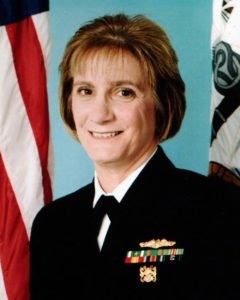 Victoria Anne Cassano, Captain, Medical Corps, U.S. Navy (Retired)
Victoria Anne Cassano, Captain, Medical Corps, U.S. Navy (Retired)
Captain Victoria Anne Cassano completed Submarine SCUBA School in Groton, Connecticut, in 1982. She earned her doctorate in medicine in 1984 and became a qualified Diving Medical Officer in 1985. In 1987 she became one of the first women qualified in submarines. Captain Cassano was the first woman to command the Naval Undersea Medical Institute from 2000–2003. In 2004 she became board certified in Undersea Medicine. She was inducted into the Women Divers Hall of Fame in 2004.
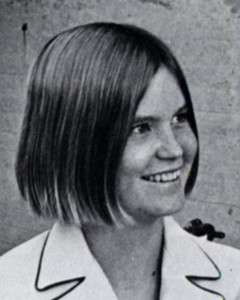 Kati Garner, Personnelman Seaman, U.S. Navy (Retired)
Kati Garner, Personnelman Seaman, U.S. Navy (Retired)
Kati Garner was the first woman to graduate U.S. Navy SCUBA diving school. When the Navy sought women for dive training in 1973, Kati jumped at the chance, bored with her WAVES typewriting classes. She persevered through the four-week SCUBA class and graduated November 30, 1973, qualifying as the Navy’s first female SCUBA diver. Kati went on to work at the Navy’s Water Survival Department and the Marine Mammal Program.
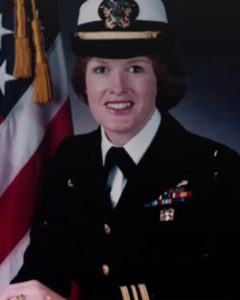 Francesca Hall, Commander, U.S. Naval Reserve (Deceased)
Francesca Hall, Commander, U.S. Naval Reserve (Deceased)
Commander Francesca Hall completed diving and salvage officer training at the U.S. Naval Diving and Salvage Training Center in Panama City, Florida, in January 1982, just over a year after the first three women qualified as diving officers. Later the same year, she graduated Basic Surface Warfare Officer School in Newport, Rhode Island. In 1983, while assigned to USS Hector (AR 7), she oversaw the underwater replacement of a 30-ton propeller on the aircraft carrier USS Enterprise (CVN 65) as the onsite diving officer, making many dives herself. Upon her retirement in 2001, Cmdr. Hall had served as the first female commanding officer of the Naval and Marine Corps Reserve Center and had earned master’s degrees in business administration and in urban and regional planning.
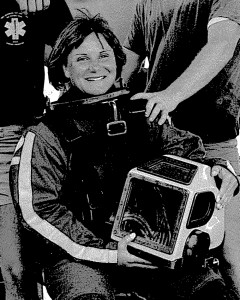 Gina Harden, Captain, U.S. Naval Reserve
Gina Harden, Captain, U.S. Naval Reserve
Captain Gina Harden completed Basic Diving Officer and Salvage School in 1982. She served as Salvage Officer for the U.S. Fifth Fleet in 1999 and as Barge Operations Officer for the USS Monitor salvage expedition 2001–2002. Captain Harden was also the Officer in Charge of Mobile Diving and Salvage Unit Two, Detachment 608, from 2000 to 2002. She has worked around the world as a Navy Diving Specialist and was inducted into the Women Divers Hall of Fame in 2003.
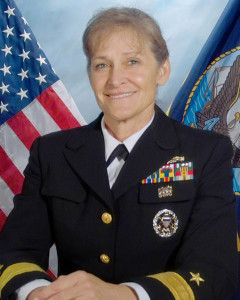 Martha Herb, Rear Admiral, U.S. Navy (Retired)
Martha Herb, Rear Admiral, U.S. Navy (Retired)
Rear Admiral Martha Herb was one of the first female officers to graduate from the Navy School of Diving and Salvage in 1980. She was the first woman at Mobile Diving and Salvage Unit One to direct the Navy’s Underwater Hull Cleaning program, and one of the first women to qualify as a Surface Warfare Officer. Rear Admiral Herb also served as the first female Officer in Charge of the Second Class Diving School for the Naval Surface Forces in the Atlantic Fleet. In 2010, she was promoted to Rear Admiral — the first female Diving Officer to hold this rank. Rear Adm. Herb retired in 2018 with almost three decades of service.
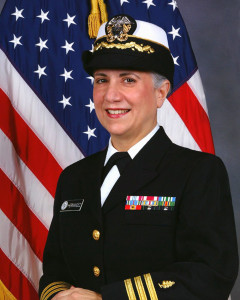 Rene S. Hernandez, Commander, Medical Service Corps, U.S. Navy (Retired)
Rene S. Hernandez, Commander, Medical Service Corps, U.S. Navy (Retired)
Commander Rene Hernandez served as a diver for the National Oceanic and Atmospheric Administration and earned her doctorate in neuroscience before joining the Navy in 1998. From 1998 to 2004 she was a research physiologist with the Operational and Undersea Medicine Department of the Naval Medicine Research Center. In 2004 she became the Director of Research for the Department of Military and Emergency Medicine at Uniformed Services University of the Health Sciences. Commander Hernandez was inducted into the Women Divers Hall of Fame in 2004.
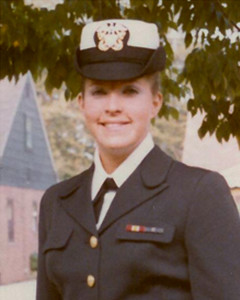 Linda Hubbell, Lieutenant Commander, U.S. Naval Reserve (Retired)
Linda Hubbell, Lieutenant Commander, U.S. Naval Reserve (Retired)
Lieutenant Commander Linda Hubbell graduated from Navy Second Class Diving School in 1976 as the first female officer to qualify as a SCUBA diver. She worked for the Navy as a marine mammal researcher from 1976 to 1978. In 1979, she became the first woman to train in an atmospheric diving suit and was also the first female officer to dive the Mark 12 Surface-Supported Diving System. Lieutenant Commander Hubbell joined the Women Divers Hall of Fame in 2005.
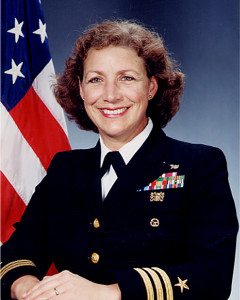 Darlene Iskra, Commander, U.S. Navy (Retired)
Darlene Iskra, Commander, U.S. Navy (Retired)
Commander Darlene Iskra graduated from the Naval School of Diving and Salvage in 1980 as one of the first female diving officers. She served as Diving Officer aboard USS Hector (ARS 7), 1980–1982, and as Executive Officer of USS Hoist (ARS 40), 1989–1990. In 1990, Commander Iskra took control of USS Opportune (ARS 41), becoming the first woman to command a commissioned Navy vessel. She served as Opportune’s Commanding Officer through 1993. In 2008, Commander Iskra was inducted into the Women Divers Hall of Fame.
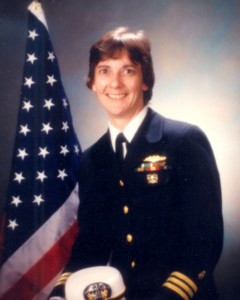 Marie E. Knafelc, Captain, Medical Corps, U.S. Navy (Retired)
Marie E. Knafelc, Captain, Medical Corps, U.S. Navy (Retired)
Captain Marie Knafelc earned her doctorate in medicine in 1980 and joined the Navy afterwards as an Undersea Medical Officer with the Navy Experimental Diving Unit. She qualified in SCUBA, mixed gas, and saturation diving. In 1982, she became the first female Submarine Medical Officer, and in 1987, the first female saturation diving Medical Officer. From 1992 to 2002, Captain Knafelc served as the Senior Medical Officer/Medical Director for the Navy Experimental Diving Unit. She was inducted into the Women Divers Hall of Fame in 2000.
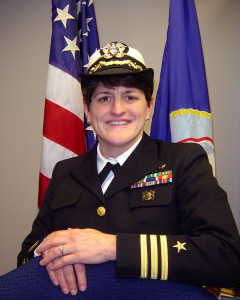 Karen Kohanowich, Commander, U.S. Navy (Retired)
Karen Kohanowich, Commander, U.S. Navy (Retired)
Commander Karen Kohanowich completed Navy Salvage and Mixed Gas Diving School in 1983. She served as Diving and Operations Officer of USS Safeguard (ARS 50), 1986–1988, and qualified as a pilot for submersible Pisces IV in 1993. From 2002 to 2005, Commander Kohanowich was the Ocean Resources Advisor to the Assistant Secretary of the Navy; in 2005, she began working for the National Oceanic and Atmospheric Administration as the Deputy Director of their Undersea Research Program. She joined the Women Divers Hall of Fame in 2001.
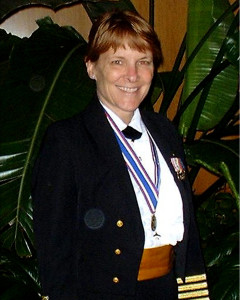 Karin Lynn, Captain, Civil Engineer Corps, U.S. Navy (Retired)
Karin Lynn, Captain, Civil Engineer Corps, U.S. Navy (Retired)
Captain Karin Lynn joined the Navy’s Civil Engineer Corps in 1977 and qualified as a Basic Diving Officer and Salvage Officer in 1983. She went on to specialize in diving and underwater systems. From 1997 to 2001, Captain Lynn was the Director of the Naval Ocean Facilities Program where she managed 250 military divers and ocean engineers. She was inducted into the Women Divers Hall of Fame in 2000.
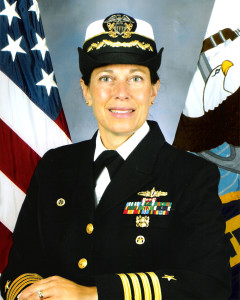 Bobbie Scholley, Captain, U.S. Navy (Retired)
Bobbie Scholley, Captain, U.S. Navy (Retired)
Captain Bobbie Scholley graduated from Basic Diving Officer School in 1983. She went on to serve as a Commanding Officer (CO) in several capacities: for USS Bolster (ARS 38) from 1992–1994, as the first female CO of Mobile Diving and Salvage Unit Two from 2000–2002, and of Naval Weapons Station Earle in New Jersey. In 1997, Captain Scholley became the first woman to serve as the Navy’s Supervisor of Diving. She was the Diving and Salvage Officer for the 1996 TWA Flight 800 recovery operation and supervised diving operations on destroyer USS Cole (DDG 67) in Yemen after it was attacked by terrorists in 2000. Captain Scholley also acted as the on-scene commander during the 2001 and 2002 USS Monitor recovery expeditions. She joined the Women Divers Hall of Fame in 2000.
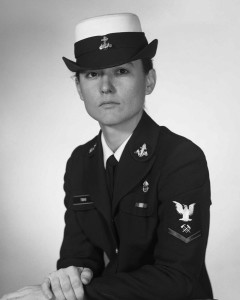 Donna Tobias, Hull Technician Second Class (Deceased)
Donna Tobias, Hull Technician Second Class (Deceased)
Hull Technician Donna Tobias graduated from the Navy’s Deep Sea Diving School in March 1975, making her the Navy’s first female deep-sea diver. She performed underwater repairs on surface ships and submarines and helped convert two barges into diving and salvage liftcraft. Donna served as a submarine escape instructor, hyperbaric chamber operator, and SCUBA instructor at the Submarine Escape Training Tank in Groton, Connecticut from 1976–1980. She was inducted into the Women Divers Hall of Fame in 2001.
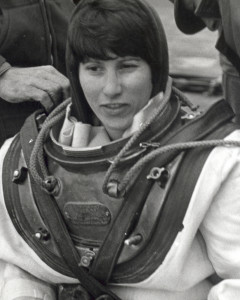 Sue Trukken, Commander, U.S. Navy (Retired)
Sue Trukken, Commander, U.S. Navy (Retired)
Commander Sue Trukken became the first female diving officer and the first female mixed gas diver upon graduating from Basic Diving and Salvage Officer Training in 1980. She joined the Navy Experimental Diving Unit as the first woman saturation diving officer in 1983. From 1989 to 1992 she served as the Executive Officer (XO) of Mobile Diving and Salvage Unit Two, and as XO at the Naval Diving and Salvage Training Center in Panama City, Florida, 1994–1996. Commander Trukken was inducted into the Women Divers Hall of Fame in 2002.
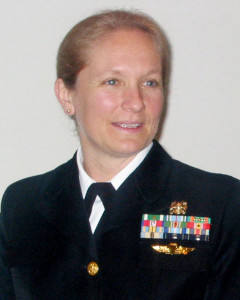 Lori Yost, Commander, U.S. Naval Reserve
Lori Yost, Commander, U.S. Naval Reserve
Commander Lori Yost completed Deep Sea Diving and Salvage Officer School in 1990. She served as Officer in Charge of Mobile Diving and Salvage Unit Two, Detachment 409, from 1999 to 2001. In 2001, Commander Yost participated in the Ehime Maru recovery operations and also dove on the USS Monitor salvages expeditions in 2001 and 2002. She joined the Women Divers Hall of Fame in 2003.

